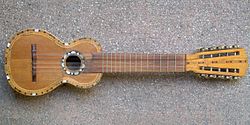Charango

A modern charango
|
|
| String instrument | |
|---|---|
| Other names | Quirquincho, Mulita, Tatu, Kirki |
| Hornbostel–Sachs classification | 321.321-5 (Composite chordophone sounded by the bare fingers) |
| Developed | Early 18th century (perhaps earlier) |
| Playing range | |
| E4 - (G6) | |
| Related instruments | |
| Walaycho; Chillador; Ronroco; et al (see text) | |
The charango is a small Andean stringed instrument of the lute family, which probably originated in the Quechua and Aymara populations in post-Columbian times, after European stringed instruments were introduced by the Spanish in the times of the colony. The instrument is widespread today throughout the Andean regions of Ecuador, Bolivia, Peru, northern Chile and northwestern Argentina, where it is a popular musical instrument which exists in many variant forms.
About 66 cm long, the charango was traditionally made with the shell from the back of an armadillo (quirquincho, mulita), but also it can be made of wood, which some believe to be a better resonator. Wood is more commonly used in modern instruments. Charangos for children may also be made from calabash. Many contemporary charangos are now made with different types of wood. It typically has 10 strings in five courses of 2 strings each, but many other variations exist.
The charango is primarily played in traditional Andean music, but is sometimes used by other Latin American musicians. A charango player is called a charanguista.
When the Spanish conquistadores came to South America, they brought the vihuela (an ancestor of the classical guitar) with them. It is not clear whether the charango is a direct descendent of a particular Spanish stringed instrument; it may have evolved from the vihuela, bandurria (mandolin), or the lute. Ernesto Cavour, charanguista, composer, and consulting music historian for many museums around the world, has noted characteristics of the charango in various vihuelas and guitars of the 16th century, and maintains the charango is the direct descendent of the vihuela.
...
Wikipedia
